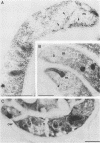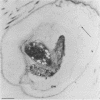Abstract
Two monoclonal antibodies (MAbs) raised against purified excysted oocysts and sporozoites of cryptosporidium parvum reacted in an immunofluorescence assay with antigens located at the anterior pole of the zoites. On Western blots of purified oocysts, these MAbs reacted with a series of bands between 210 and 40 kDa; several of these bands were recognized by both MAbs; others were specific. One MAb (TOU) did not react after periodic acid treatment and was therefore considered to recognize a carbohydrate epitope; as determined by immunoelectron microscopy, this MAb reacted on micronemes of sporozoites and merozoites and also with the peripheral cytoplasm and the parasitophorous vacuole of trophozoites and macrogametes. The other MAb (HAD) reacted with an epitope that was insensitive to periodate treatment but did not react in the immunoelectron microscopy assay. However, the similar labeling pattern obtained with the immunofluorescence assay with both MAbs and the fact that the two antibodies share common bands on Western immunoblots suggest that both MAbs react with molecules located in Cryptosporidium micronemes, one reacting with a glycannic epitope and the other reacting with a peptidic epitope.
Full text
PDF

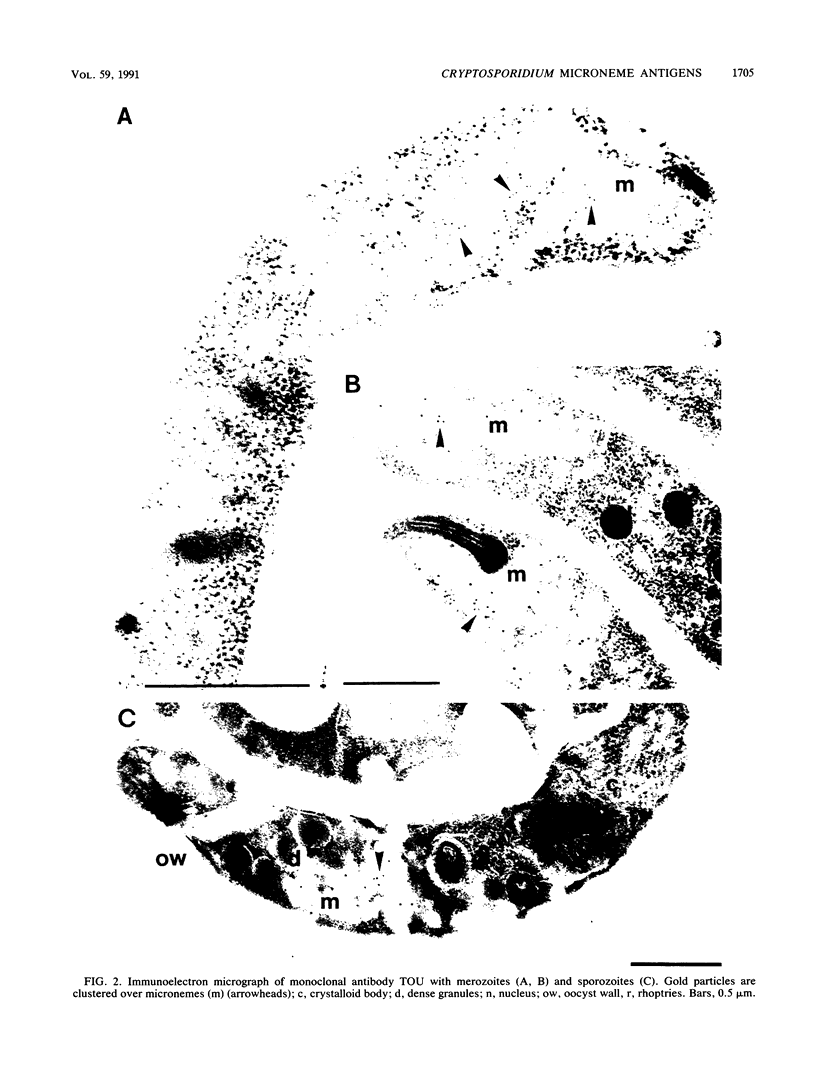
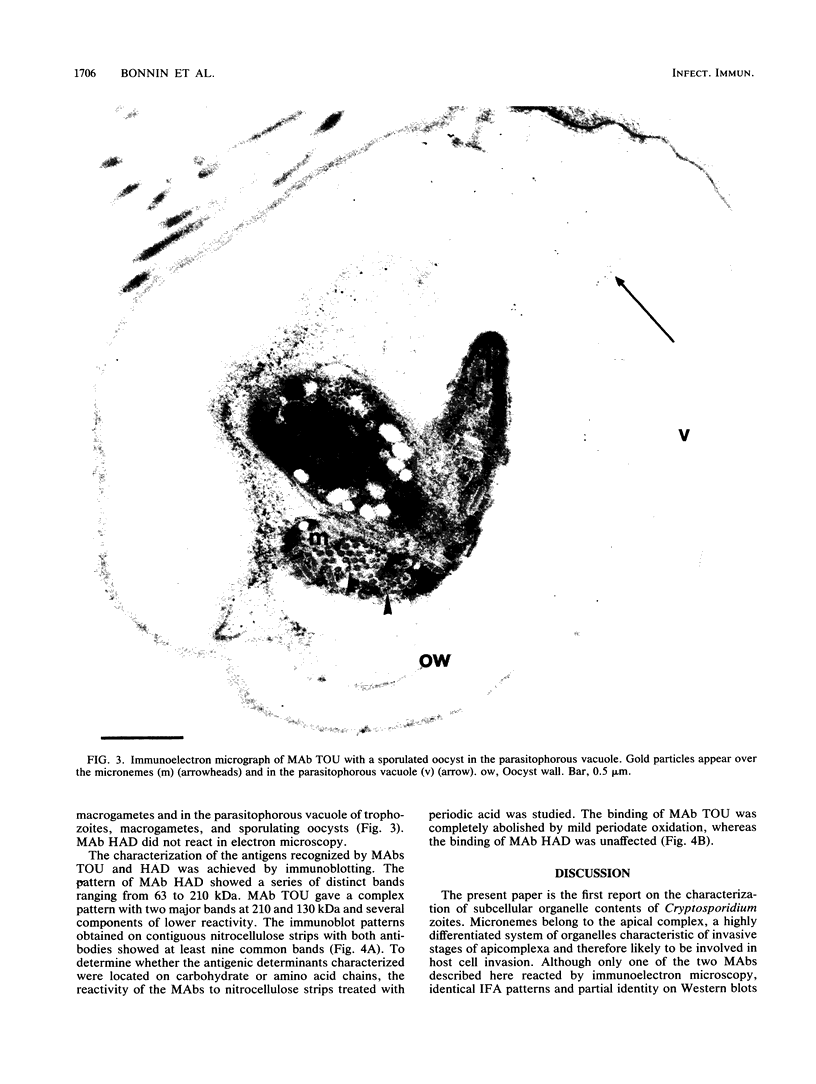
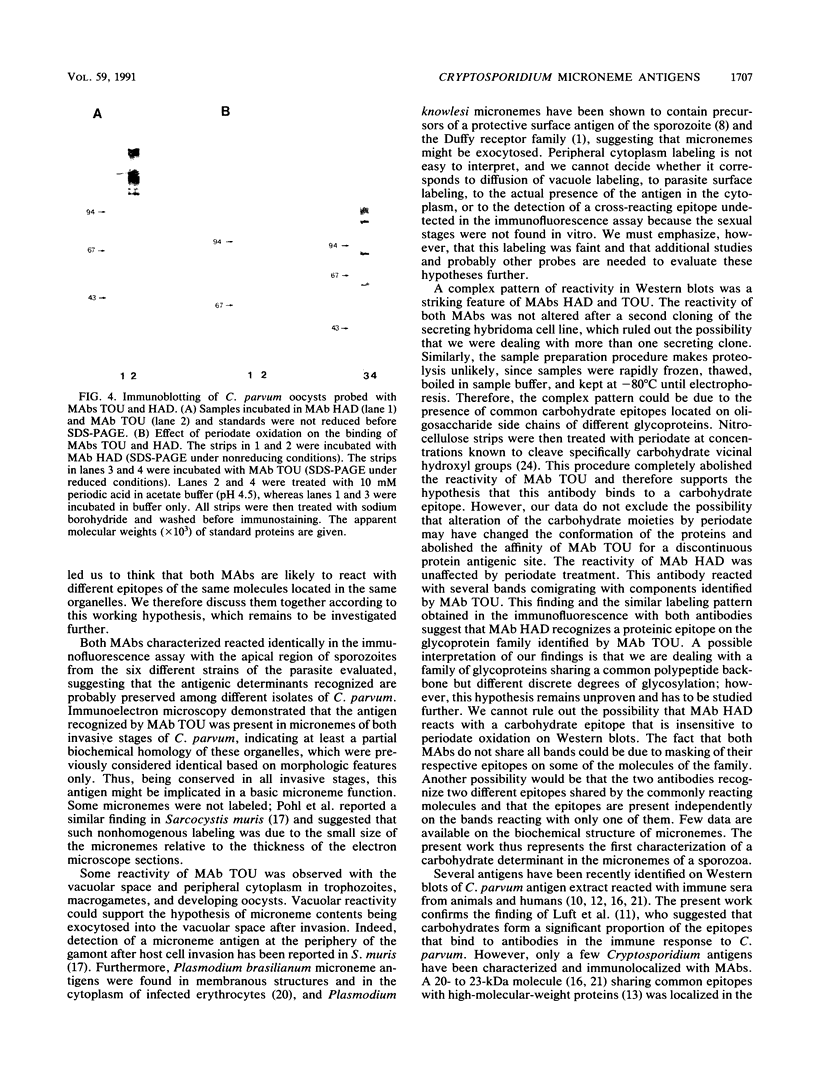
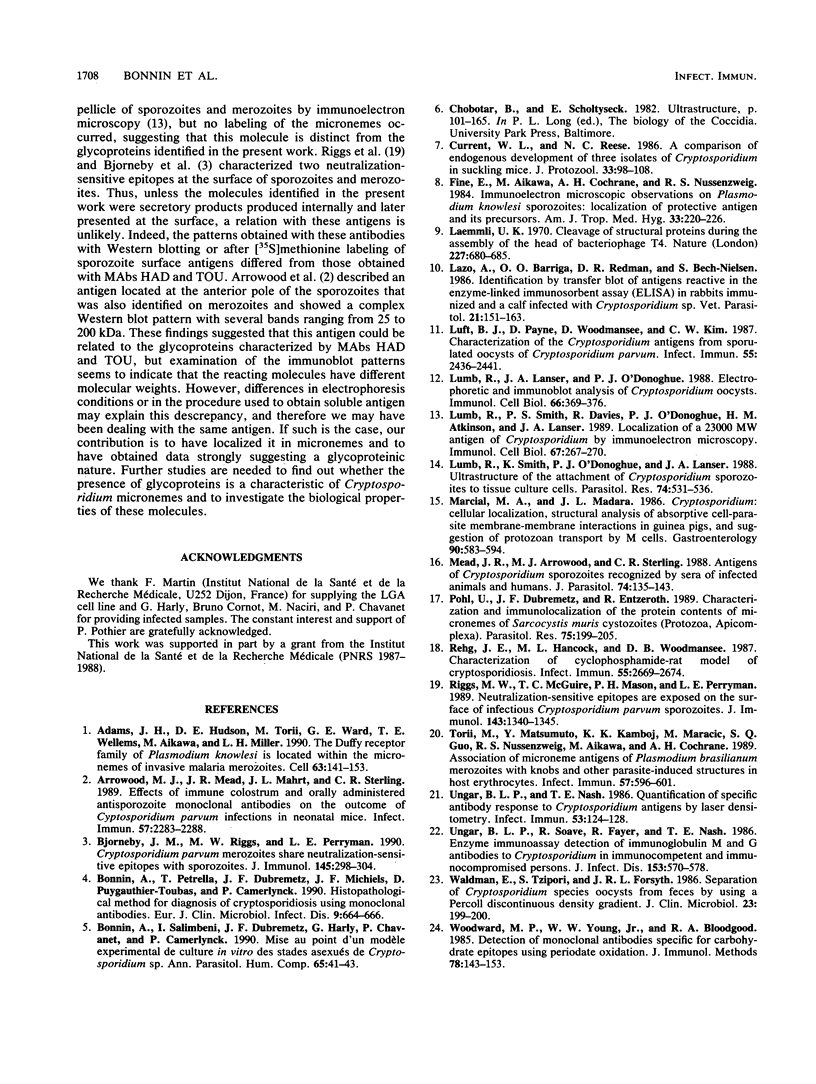
Images in this article
Selected References
These references are in PubMed. This may not be the complete list of references from this article.
- Adams J. H., Hudson D. E., Torii M., Ward G. E., Wellems T. E., Aikawa M., Miller L. H. The Duffy receptor family of Plasmodium knowlesi is located within the micronemes of invasive malaria merozoites. Cell. 1990 Oct 5;63(1):141–153. doi: 10.1016/0092-8674(90)90295-p. [DOI] [PubMed] [Google Scholar]
- Arrowood M. J., Mead J. R., Mahrt J. L., Sterling C. R. Effects of immune colostrum and orally administered antisporozoite monoclonal antibodies on the outcome of Cryptosporidium parvum infections in neonatal mice. Infect Immun. 1989 Aug;57(8):2283–2288. doi: 10.1128/iai.57.8.2283-2288.1989. [DOI] [PMC free article] [PubMed] [Google Scholar]
- Bjorneby J. M., Riggs M. W., Perryman L. E. Cryptosporidium parvum merozoites share neutralization-sensitive epitopes with sporozoites. J Immunol. 1990 Jul 1;145(1):298–304. [PubMed] [Google Scholar]
- Bonnin A., Petrella T., Dubremetz J. F., Michiels J. F., Puygauthier-Toubas D., Camerlynck P. Histopathological method for diagnosis of cryptosporidiosis using monoclonal antibodies. Eur J Clin Microbiol Infect Dis. 1990 Sep;9(9):664–666. doi: 10.1007/BF01964268. [DOI] [PubMed] [Google Scholar]
- Current W. L., Reese N. C. A comparison of endogenous development of three isolates of Cryptosporidium in suckling mice. J Protozool. 1986 Feb;33(1):98–108. doi: 10.1111/j.1550-7408.1986.tb05567.x. [DOI] [PubMed] [Google Scholar]
- Fine E., Aikawa M., Cochrane A. H., Nussenzweig R. S. Immuno-electron microscopic observations on Plasmodium knowlesi sporozoites: localization of protective antigen and its precursors. Am J Trop Med Hyg. 1984 Mar;33(2):220–226. doi: 10.4269/ajtmh.1984.33.220. [DOI] [PubMed] [Google Scholar]
- Laemmli U. K. Cleavage of structural proteins during the assembly of the head of bacteriophage T4. Nature. 1970 Aug 15;227(5259):680–685. doi: 10.1038/227680a0. [DOI] [PubMed] [Google Scholar]
- Lazo A., Barriga O. O., Redman D. R., Bech-Nielsen S. Identification by transfer blot of antigens reactive in the enzyme-linked immunosorbent assay (ELISA) in rabbits immunized and a calf infected with Cryptosporidium sp. Vet Parasitol. 1986 Aug;21(3):151–163. doi: 10.1016/0304-4017(86)90062-2. [DOI] [PubMed] [Google Scholar]
- Luft B. J., Payne D., Woodmansee D., Kim C. W. Characterization of the Cryptosporidium antigens from sporulated oocysts of Cryptosporidium parvum. Infect Immun. 1987 Oct;55(10):2436–2441. doi: 10.1128/iai.55.10.2436-2441.1987. [DOI] [PMC free article] [PubMed] [Google Scholar]
- Lumb R., Lanser J. A., O'Donoghue P. J. Electrophoretic and immunoblot analysis of Cryptosporidium oocysts. Immunol Cell Biol. 1988 Oct-Dec;66(Pt 5-6):369–376. doi: 10.1038/icb.1988.48. [DOI] [PubMed] [Google Scholar]
- Lumb R., Smith K., O'Donoghue P. J., Lanser J. A. Ultrastructure of the attachment of Cryptosporidium sporozoites to tissue culture cells. Parasitol Res. 1988;74(6):531–536. doi: 10.1007/BF00531630. [DOI] [PubMed] [Google Scholar]
- Lumb R., Smith P. S., Davies R., O'Donoghue P. J., Atkinson H. M., Lanser J. A. Localization of a 23,000 MW antigen of Cryptosporidium by immunoelectron microscopy. Immunol Cell Biol. 1989 Aug;67(Pt 4):267–270. doi: 10.1038/icb.1989.40. [DOI] [PubMed] [Google Scholar]
- Marcial M. A., Madara J. L. Cryptosporidium: cellular localization, structural analysis of absorptive cell-parasite membrane-membrane interactions in guinea pigs, and suggestion of protozoan transport by M cells. Gastroenterology. 1986 Mar;90(3):583–594. doi: 10.1016/0016-5085(86)91112-1. [DOI] [PubMed] [Google Scholar]
- Mead J. R., Arrowood M. J., Sterling C. R. Antigens of Cryptosporidium sporozoites recognized by immune sera of infected animals and humans. J Parasitol. 1988 Feb;74(1):135–143. [PubMed] [Google Scholar]
- Pohl U., Dubremetz J. F., Entzeroth R. Characterization and immunolocalization of the protein contents of micronemes of Sarcocystis muris cystozoites (Protozoa, Apicomplexa). Parasitol Res. 1989;75(3):199–205. doi: 10.1007/BF00931276. [DOI] [PubMed] [Google Scholar]
- Rehg J. E., Hancock M. L., Woodmansee D. B. Characterization of cyclophosphamide-rat model of cryptosporidiosis. Infect Immun. 1987 Nov;55(11):2669–2674. doi: 10.1128/iai.55.11.2669-2674.1987. [DOI] [PMC free article] [PubMed] [Google Scholar]
- Riggs M. W., McGuire T. C., Mason P. H., Perryman L. E. Neutralization-sensitive epitopes are exposed on the surface of infectious Cryptosporidium parvum sporozoites. J Immunol. 1989 Aug 15;143(4):1340–1345. [PubMed] [Google Scholar]
- Torii M., Matsumoto Y., Kamboj K. K., Maracic M., Guo S. Q., Nussenzweig R. S., Aikawa M., Cochrane A. H. Association of microneme antigens of Plasmodium brasilianum merozoites with knobs and other parasite-induced structures in host erythrocytes. Infect Immun. 1989 Feb;57(2):596–601. doi: 10.1128/iai.57.2.596-601.1989. [DOI] [PMC free article] [PubMed] [Google Scholar]
- Ungar B. L., Nash T. E. Quantification of specific antibody response to Cryptosporidium antigens by laser densitometry. Infect Immun. 1986 Jul;53(1):124–128. doi: 10.1128/iai.53.1.124-128.1986. [DOI] [PMC free article] [PubMed] [Google Scholar]
- Ungar B. L., Soave R., Fayer R., Nash T. E. Enzyme immunoassay detection of immunoglobulin M and G antibodies to Cryptosporidium in immunocompetent and immunocompromised persons. J Infect Dis. 1986 Mar;153(3):570–578. doi: 10.1093/infdis/153.3.570. [DOI] [PubMed] [Google Scholar]
- Waldman E., Tzipori S., Forsyth J. R. Separation of Cryptosporidium species oocysts from feces by using a percoll discontinuous density gradient. J Clin Microbiol. 1986 Jan;23(1):199–200. doi: 10.1128/jcm.23.1.199-200.1986. [DOI] [PMC free article] [PubMed] [Google Scholar]
- Woodward M. P., Young W. W., Jr, Bloodgood R. A. Detection of monoclonal antibodies specific for carbohydrate epitopes using periodate oxidation. J Immunol Methods. 1985 Apr 8;78(1):143–153. doi: 10.1016/0022-1759(85)90337-0. [DOI] [PubMed] [Google Scholar]




